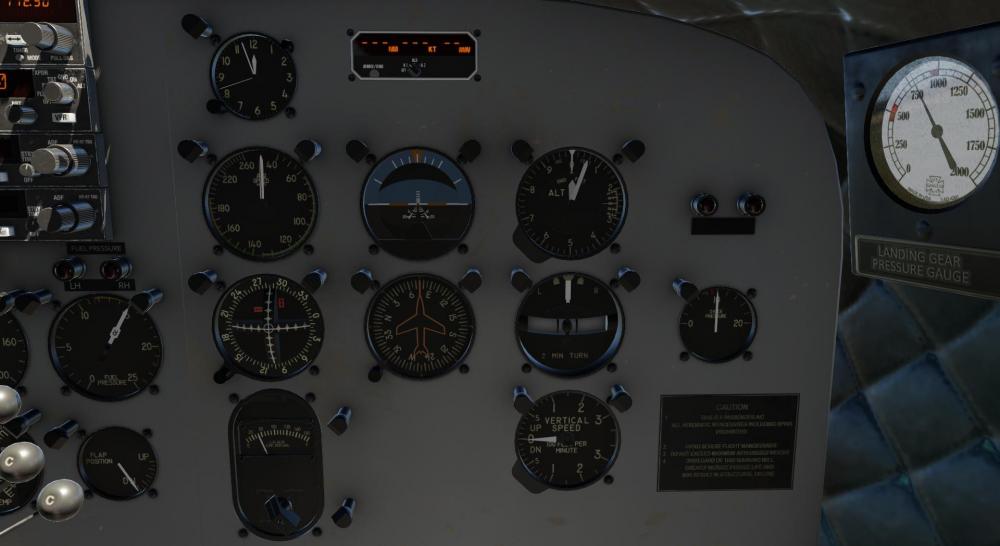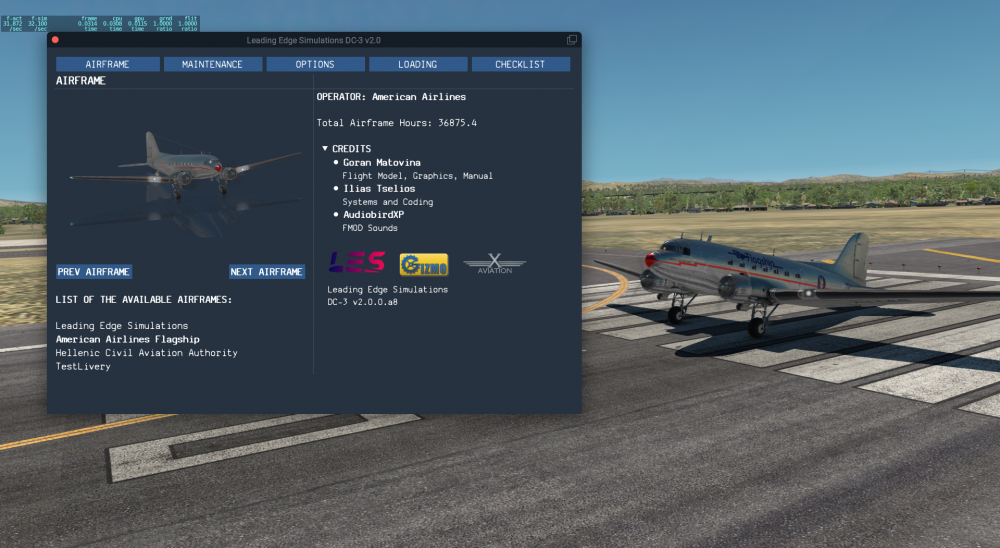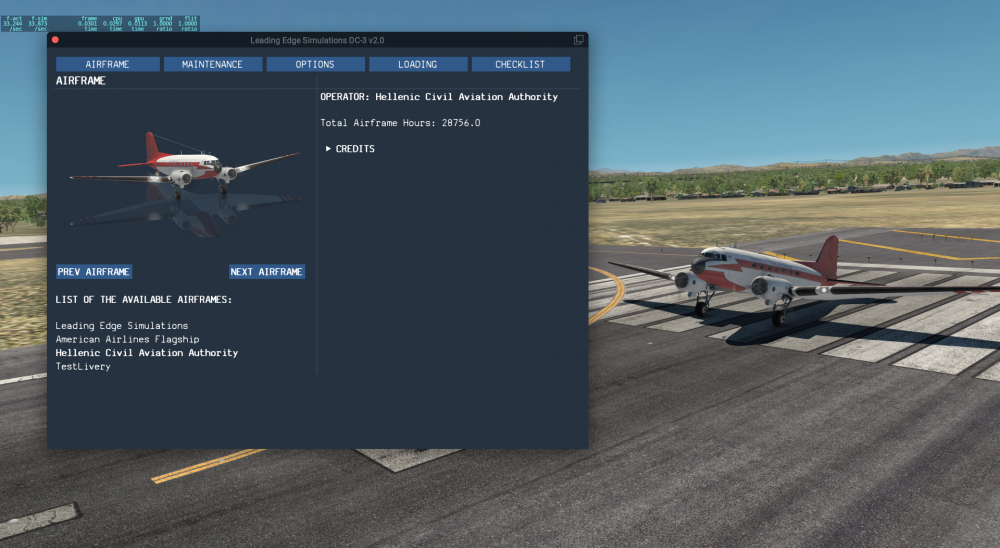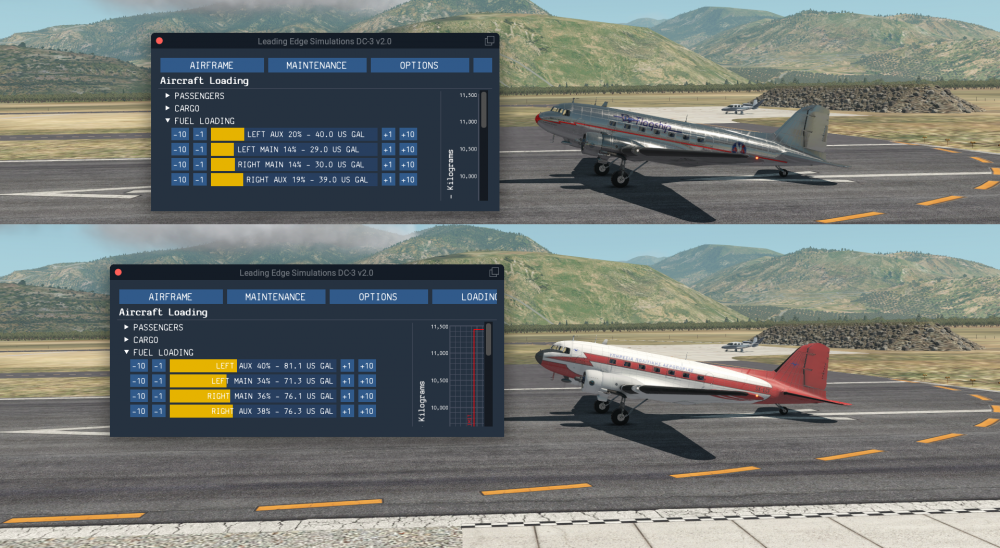Leaderboard
Popular Content
Showing content with the highest reputation on 09/06/2023 in all areas
-
Thanks about this DC3, it looks amazing and i will buy it tmw when available. Can we have access to a paintkit for it? Thank You!!!1 point
-
Friend, be calm and patient. We might never have that bird again on current platforms. Have you ever thought about it? So let's be thankful that we will have this.1 point
-
Tell me you don't understand what goes into these things without telling me you don't know what goes into these things. There is a very good explanation of why we have been waiting as long as we have if you'll just use your eyes to read the thread.1 point
-
Dear Captains, Has been a long time since the last update, but we have been working continuously, especially the last months. We are now at the point, that this might be the last developer's update before release. X-Plane 12 As you already know, a lot of things happened the last year; the biggest one, the release of X-Plane 12. We were participating in X-Plane 12 alpha testing, from day one, and while we were proving feedback to Laminar, we also testing DC-3's compatibility, and how we will react to this change. Initially, without knowing XP12 release date, we were planning to release for XP11. But around Autumn, with the X-Plane 12 beta out, it was obvious we had to support X-Plane 12 as well. In those testing days, we were continuously switching between X-Plane versions, to be sure that things work right for both simulators. But, with the new stuff X-Plane 12 brought, it was obviously that we cannot have a common aircraft for both versions. Even we tried to have a version with only what works in both version, but that was going to be a half-baked product, so was no go. Also we took a decision (read below), that would have made parallel development impossible. Given the extension of our development roadmap, we were sure that DC-3 release will happen after the official X-Plane 12 release. So, we decided to move forward and support only X-Plane 12. Introducing DC-3, Modern aircraft version! While all the above was going on, brainstorming together with our beta testers, we decided to create a second aircraft with more modern avionics. While the, the now named, DC-3 Classic gives you all the vibes of the 1940's technology, it was going to be hard, if not impossible to perform flights specially in online networks. Also, the newer, "Modern" aircraft is more accessible to more pilots, having instrumentation that is very well known, widely used. Of course, that does not mean, just drop a few instrument (idk... like G1000s ) and call it a day. Everything designed and developed to work as per manuals. Here what is new: Pilots' Stations: 1. Pilot's HSI: Bendix/King KI-525A. 2. Pilot's RMI: Bendix/King KNI-582 Dual Pointer RMI. 3. 2 Course Indicators, one for each pilot. 4. 2 independent KDI-572 DME indicators, one for each pilot. Radio Stack: 1. Bendix/King KAP-140 Autopilot - Two Axis with Altitude Preselect. 2. X-Plane's GNS 530, with support for RealityXP's 530, which also provides controls for COM1/NAV1. 3. Bendix/King KX-165A VHF COM/NAV transceiver, for COM2 and NAV2 tuning. 4. Bendix/King KT-73 Transponder. 5. 2 Bendix/King KR-87 Silver Crown ADF systems. All radios and autopilot are fully simulated and perform all normal operations, as described in their manuals. For the rest of the systems, they were updated were needed, and adapted to operate with the new aircraft. The maintenance and airframe systems, are also apply to the Modern aircraft as well. Conclusion We are reaching the final stretch of this development road, and will be very happy to provide you 2 aircraft, the Classic for the vintage aircraft enthusiasts, and the Modern, which is more capable, in terms of IFR operations. Time for a couple screenshot of the new aircraft, right? (of course still WIP!)1 point
-
Every operation will be somewhat different of course.... Once we complete the last leg of the day and the shutdown check is complete, one of us is immediately getting up out of the seat to open the cabin door and go verify chocks are in place, the nose doors are opened, and 5 pins are inserted. Of course if our last leg is a passenger leg - they are disembarked first. One pilot typically stays with them for the walk to the vehicles or the FBO - while the other pilot heads to the interior of the baggage compartment to pass the bags to line crew. That pilot then comes through the cabin to check for forgotten personal items - concluding with a thumbs up to the pilot adjacent the vehicles. If they walked inside - typically a text is sent between pilots that the cabin is clear (or isn't). At this point the pilot with the airplane will coordinate with the line crew re: required services - verifying chocks are in place - then retrieving the pins and inserting them. Different operations have different philosophies/standards regarding nose doors opened or closed. At our home base - we will always open the doors and insert 5 pins. Away from home while on the road we can exercise discretion to leave them closed. In a location with security concerns, or if there are any concerns regarding tugs, line crew, etc - we may elect to go with 3 pins and leave the doors closed. I'd say in our operation the doors are left open with 5 pins the majority of the time. Under no circumstance will we leave the nose doors open without inserting the 2 additional pins. Once pins are inserted and we're both back on the jet - it's time to start cleaning up and preparing for the next flight. Garbage is gathered, old coffee is dumped, drinks in the drawer with paper labels are removed from the ice bins - leftover catering is emptied from the chiller and either given to line crew as trash, as a gift, or to be stored in the FBO fridge. If the cabin needs to be vacuumed - we vacuum while power is still on. Tables and surfaces are cleaned at this point, seatbelts are cleaned and put back into presentation , the sinks and lav are cleaned and while this is happening - line crew is probably performing the lav service. Dishes and linens are given to line service as well. We like to keep power on until all of that is finished so we can check the lav - that enough (hopefully clean) water has been put back in and its back to smelling/looking fresh. We also have to restock from the storage drawers in back. Things like snacks, drinks, chips etc - all have to be replenished. If 15 minutes has gone by - one pilot is checking/servicing the oils in the utility bay. If temps will dip towards or below freezing - we purge the potable water system. This is often done at TOD depending on circumstances to avoid dumping 10 gallons of potable water on an FBO ramp which will turn into an iceberg. Water lines must be purged on the ground which is similar to prepping a recreational vehicle or boat for winter storage , minus the antifreeze, although there's different techniques there too. Sometimes during all of this we may also fuel for the next day's flight - circumstances of course dictate when we would do this as there are considerations to keep in mind leaving the jet with a lot of fuel. We also will consolidate crew baggage and put it in the baggage door opening in preps for offloading. We ensure the garbage, catering, fridge items, etc - are indeed all off. The parking brake at this point has probably long been released since chocks were verified - and the signs put in the cockpit windows indicating the jet is safe to tow. We verify one of us has recorded the 'numbers' from the FMS for the trip paperwork. (OFF/ON/FLIGHT times and OUT/IN Fuel) Suction cupped iPad mounts are removed from the windows, the Sentry is verified as off and packed up so it can be charged at the hotel if needed. If it was a night flight and next flight is day, and we're about to secure the airplane - lights will be brought back to a daytime config (full bright). If it's a hot and sunny location - cabin window shades are closed and cockpit reflective covers are put in place. We also have a pin to secure the emergency exit in the cabin that gets inserted. At this point we verify requested services have been received/completed and we check with the other crewmember or crewmembers that they are done with cabin power. From here one of us typically runs the securing checklist and shuts down the APU. But we aren't done yet. Our bags get unloaded at this point and we build our 'pile'. All external panels are locked. A thorough post flight walk-around is completed, typically by both of us. Covers are put on all 3 pitots, both ice detectors, the AOA cone and both AOA vanes. Both batteries are disconnected. Whichever pilot didn't do the cockpit securing - must 'check switches' to make sure all is where it should be. Now it is finally time to make sure everyone is 'done inside' and the door gets closed/locked - and now - we can walk into the FBO, or to our rental car which has been brought planeside. We check in at the CSR desk regardless - providing contact info, verifying the schedule and services requested. This is a great time to make sure we go over the 'stuff in the fridge, the lav service, hangar arrangements, etc etc'. Only after this is all done do we leave the airport and head to the hotel where the trip PIC does 'the paperwork' which in our operation is electronic and must be submitted in a reasonable amount of time after the flight. At home base our operation has a cleaning service that will take care of many of the above tasks, and since another leg often isn't happening the next day - we're off the airplane pretty quickly. Hope this helps understand some of the things that go into this side of the business. On an international arrival after a long day mid-trip- it wouldn't be uncommon for the crew to take 30-45 minutes to do all of the above correctly.1 point
-
From your log: D:\X-Plane 11/X-Plane 11/Aircraft/X-Aviation/Cessna 172SP G5/plugins/G5/win_x64/G5.xpl : Error Code = 126 : The specified module could not be found. https://support.torquesim.com/hc/en-us/articles/360057635513-Steps-to-resolve-plugins-not-loading-Error-Code-126-1 point
-
Long time to write an update, so let's go! By the way, if you have discord, feel free to join our discord channel https://discord.gg/tQWCRGngcw , we will be happy to welcome you there! May be the title does not makes much sense, but bare with me, it will! We are changing the usual way that liveries work. In our DC3, will not be just extra some extra external paints, but much more. Each livery will represent a specific airframe. This means that each livery comes along with its own persistence system, own operating hours, and of course will follow its own maintenance schedule (which will be analyzed in the next post). This means, that as you fly with one livery, flying hours, etc. will be added to that specific livery/airframe. Change to a different airframe (or livery), will be almost like change aircraft. Note: the systems remain the same. But, you may ask, if someone wants to add a livery, how is going to work? We are tracking the various values through a couple text files, that exist in each livery folder. So there are 2 options: 1. You can copy the specific files from an existing livery, and if you like, change some values. 2. Do not add anything. When you load the livery for the first time, the files from the default livery will be copied over to the correct place. Within the aircraft package, will be detailed instructions of how to add a livery. That’s all for now, here are some shot with the respective GUI:1 point










